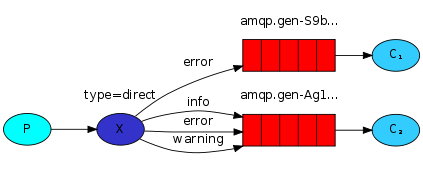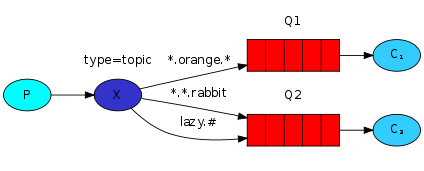python网络篇【第十二篇】RabbitMQ
RabbitMQ
MQ全称为Message Queue, 消息队列(MQ)是一种应用程序对应用程序的通信方法。应用程序通过读写出入队列的消息(针对应用程序的数据)来通信,而无需专用连接来链接它们。消 息传递指的是程序之间通过在消息中发送数据进行通信,而不是通过直接调用彼此来通信,直接调用通常是用于诸如远程过程调用的技术。排队指的是应用程序通过 队列来通信。队列的使用除去了接收和发送应用程序同时执行的要求。
RabbitMQ Server: 是一种传入服务。 它的角色是维护一条从生产者(Producer) 到 消费者(Consumer)的路线,从而保证数据能够按照指定的方式进行传入。但是也并不是100%的保证数据完整,对于普通的应用来说,应该是足够的。当然对于要求可靠性、完整性绝对的场景,可以再走一层数据一致性的guard, 就可以保证了。
RabbitMQ安装:
安装配置epel源 $ rpm -ivh http://dl.fedoraproject.org/pub/epel/6/i386/epel-release-6-8.noarch.rpm 安装erlang $ yum -y install erlang 安装RabbitMQ $ yum -y install rabbitmq-server
启动关闭:service rabbitmq-server start/stop
安装API:
pip3 install pika
基于Queue实现生产者消费者模型:
import queue import threading m=queue.Queue() def producer(i): while True: m.put(i) def consumer(i): while True: g=m.get(i) print(g) for i in range(12): t=threading.Thread(target=producer,args=(i,)) t.start() for i in range(10): t=threading.Thread(target=consumer,args=(i,)) t.start()
对于RabbitMQ来说,生产和消费不再针对内存里的一个Queue对象,而是某台服务器上的RabbitMQ Server实现的消息队列。相当于C/S架构了。
生产者:
#####生产者: import pika connection=pika.BlockingConnection( pika.ConnectionParameters(host="192.168.1.129") #建立TCP连接,端口不写代表默认 ) chanel=connection.channel() #虚拟连接,建立在上面的TCP连接基础之上 ##为什么使用Channel,而不用TCP连接? #因为对于OS来说,建立和关闭TCP连接是有代价的,尤其是频繁的建立和关闭. 而且TCP的连接数默认在系统内核中也有限制, 这也限制了系统处理高并发的能力. #但是,如果在TCP连接中建立 Channel是没有代价的,对于Procuder或者Consumer来讲,可以并发的使用多个channel来进行publish或者receive. chanel.queue_declare(queue="Tom") #创建一个,队列名字为Tom chanel.basic_publish( exchange="", #信息是不能直接发送到队列的,它需要发送到交换机(exchange),下面会谈这个,此处使用一个空字符串来标识. routing_key="Tom", #必须指定队列的的名称 body="Hello Tom" , # 所要发送的信息 ) print("Send OK") connection.close() #关闭连接
消费者:
import pika connection = pika.BlockingConnection( pika.ConnectionParameters(host='192.168.1.129') ) channel=connection.channel() channel.queue_declare("Tom") def callback(ch,method,properties,body): ''' 回调方法,当我们获取到信息的时候,Pika库就会调用此函数,这个回调函数会将接收到的信息内容输出到屏幕上 :param ch: 虚拟通道 :param method: 方法 :param properties: 信息属性 :param body: 接收到的信息 :return: ''' print("Received:%r"%body) while True: channel.basic_consume( #需要告诉RabbitMQ这个灰调函数将会从名为“Tom”的队列中接收信息: callback, queue="Tom", no_ack=True, ) print("Wating for message ,To exit press CTRL+C") channel.start_consuming()
1. 消息确认
避免信息丢失,RabbitMQ提供了消息响应(acknowledgments)。消费者会通过一个ack(响应),告诉RabbitMQ已经收到并处理了某条消息,然后RabbitMQ就会释放并删除这条消息。如果消费者(consumer)挂掉了,没有发送响应,RabbitMQ就会认为消息没有被完全处理,然后重新发送给其他消费者(consumer)。这样,及时工作者(workers)偶尔的挂掉,也不会丢失消息。
消息是没有超时这个概念的;当工作者与它断开连的时候,RabbitMQ会重新发送消息。这样在处理一个耗时非常长的消息任务的时候就不会出问题了。
消息响应:默认是开启的 no_ack, 在上面的例子中,我们把标识给置为True(关闭了)。开启后,完成一个任务后,会发送一个响应。
no-ack = False,如果消费者遇到情况(its channel is closed, connection is closed, or TCP connection is lost)挂掉了,那么,RabbitMQ会重新将该任务添加到队列中
import pika import time connection = pika.BlockingConnection( pika.ConnectionParameters(host='192.168.1.129') ) channel=connection.channel() channel.queue_declare("Tom") def callback(ch,method,properties,body): ''' 回调方法,当我们获取到信息的时候,Pika库就会调用此函数,这个回调函数会将接收到的信息内容输出到屏幕上 :param ch: 虚拟通道 :param method: 方法 :param properties: 信息属性 :param body: 接收到的信息 :return: ''' print("Received:%r"%body) time.sleep(20) print("ok") ch.basic_ack(delivery_tag=method.delivery_tag) #信息不丢失 while True: channel.basic_consume( #需要告诉RabbitMQ这个灰调函数将会从名为“Tom”的队列中接收信息: callback, queue="Tom", no_ack=False, #这个地方改为False ) print("Wating for message ,To exit press CTRL+C") channel.start_consuming()
2. 消息持久化
有个参数durable, 默认情况下,如果没有显式告诉RabbitMQ这条消息需要持久化,那么它(rabbitmq)在自己退出或者崩溃的时候,将会丢失所有队列和消息。
为了确保不丢失,需要注意:
必须把队列和消息设置为持久化。
#####生产者##### import pika connection=pika.BlockingConnection( pika.ConnectionParameters(host="192.168.1.129") ) channel=connection.channel() channel.queue_declare(queue="Tom") channel.basic_publish( exchange="", routing_key="Tom", body="Hello Tom", properties=pika.BasicProperties(delivery_mode=2) #持久化 ) print("[x] Sent 'Hello Tom!'") connection.close()
#####消费者###### import pika connection = pika.BlockingConnection( pika.ConnectionParameters(host='192.168.1.129') ) channel = connection.channel() channel.queue_declare('Tom') #使用queue_declare创建一个队列——我们可以运行这个命令很多次,但是只有一个队列会被创建。 def callback(ch, method, properties, body): ''' 回调方法,当我们获取到消息的时候,Pika库就会调用此回调函数。这个回调函数会将接收到的消息内容输出到屏幕上。 :param ch: 虚拟通道 :param method: 方法 :param properties: 消息属性 :param body: 消息主体 :return: ''' print('Received: %r' %body) ch.basic_ack(delivery_tag=method.delivery_tag) while True: channel.basic_consume( #需要告诉RabbitMQ这个回调函数将会从名为"Tom队列中接收消息: callback, queue='Tom', no_ack=False #no_ack 置为False ) print('Wating for messages. To exit press CTRL+C') channel.start_consuming()
3、消息获取顺序
默认消息队列里的数据是按照顺序被消费者拿走,例如:消费者1 去队列中获取 奇数 序列的任务,消费者1去队列中获取 偶数 序列的任务。
channel.basic_qos(prefetch_count=1) 表示谁来谁取,不再按照奇偶数排列
#!/usr/bin/env python3 # -*- coding: utf-8 -*- ################################消费者########################################### import pika connection = pika.BlockingConnection( pika.ConnectionParameters(host='192.168.1.129') ) channel = connection.channel() channel.queue_declare('Tom') #使用queue_declare创建一个队列——我们可以运行这个命令很多次,但是只有一个队列会被创建。 def callback(ch, method, properties, body): ''' 回调方法,当我们获取到消息的时候,Pika库就会调用此回调函数。这个回调函数会将接收到的消息内容输出到屏幕上。 :param ch: 虚拟通道 :param method: 方法 :param properties: 消息属性 :param body: 消息主体 :return: ''' print('Received: %r' %body) ch.basic_ack(delivery_tag=method.delivery_tag) channel.basic_qos(prefetch_count=1) #设置 prefetch_count=1,告诉RabbitMQ,在同一时刻,不要发送超过一条消息给一个worker,直到它处理了上一条消息并且做出了响应。 while True: channel.basic_consume( #需要告诉RabbitMQ这个回调函数将会从名为"Tom"的队列中接收消息: callback, queue='Tom', no_ack=False ) print('Wating for messages. To exit press CTRL+C') channel.start_consuming()
4. 发布/订阅
分发一个消息给多个消费者(Consumers), 这种模式,称为"发布/订阅"
发布者只需要把消息发送给exchange。exchange一边从发布者放接受消息,一边推送到队列。
exchange必须知道如何处理它接收到的消息,是应该推送到指定的队列还是是多个队列,或者是直接忽略消息。这些规则是通过交换机类型(exchange type)来定义的。
exchange的几个类型:
direct: 直连, 通过binding key的完全匹配来传递消息到相应的队列中
topic:主题交换机,exchange将传入的”路由值“ 和”关键字“进行匹配,匹配成功,则将数据发送到指定队列。
- # 表示可以匹配0个 或者多个单词
- * 表示只能匹配一个单词
发送者路由值 队列中 old.boy.python old.* -- 不匹配 old.boy.python old.# -- 匹配
fanout:扇形交换机, 把消息发送给和他关联的所有的队列
fanout,绑定(binding)模式
exchange type = fanout

import pika #导入模块 connection = pika.BlockingConnection( pika.ConnectionParameters(host='192.168.1.129') #端口如果是默认的话,不用写 ) #建立TCP连接 channel = connection.channel() #虚拟连接,建立在上面的TCP连接基础上 channel.exchange_declare(exchange="logs", type="fanout") #使用fanout类型 message="Hello,Tom and jerry!" channel.basic_publish( exchange="logs", #消息是不能直接发送到队列的,它需要发送到交换机(exchange),exchange值必须为定义好的exchange值 routing_key="", body=message, #所要发送的信息 ) print(" [x] Sent %s"%message) connection.close() #关闭连接

#!/usr/bin/env python3 # -*- coding: utf-8 -*- # fanout ################################消费者########################################### import pika connection = pika.BlockingConnection( pika.ConnectionParameters(host='192.168.1.129') ) channel = connection.channel() channel.exchange_declare( exchange='logs', type='fanout' ) result = channel.queue_declare(exclusive=True) queue_name = result.method.queue channel.queue_bind( exchange='logs', queue=queue_name ) print('Wating for messages. To exit press CTRL+C') def callback(ch, method, properties, body): ''' 回调方法,当我们获取到消息的时候,Pika库就会调用此回调函数。这个回调函数会将接收到的消息内容输出到屏幕上。 :param ch: 虚拟通道 :param method: 方法 :param properties: 消息属性 :param body: 消息主体 :return: ''' print('Received: %r' %body) ch.basic_ack(delivery_tag=method.delivery_tag) while True: channel.basic_consume( #需要告诉RabbitMQ这个回调函数将会从名为"hello"的队列中接收消息: callback, queue=queue_name, no_ack=False ) channel.start_consuming()
direct,多个绑定(关键字)

多个队列使用相同的绑定键是合法的。上图这个例子中,我们可以添加一个X和Q1之间的绑定,使用black绑定键。这样一来,直连交换机就和扇型交换机的行为一样,会将消息广播到所有匹配的队列。带有black路由键的消息会同时发送到Q1和Q2。


import pika import sys connection = pika.BlockingConnection(pika.ConnectionParameters( host='192.168.11.87')) channel = connection.channel() channel.exchange_declare(exchange='TOM', type='direct') #使用direct类型 severity = 'info' #如果生产者发送一个info消息的话,两个消费者都能收到; 如果发送一个error级别的消息,只有 error级别的能收到.. message ="info,123" channel.basic_publish(exchange='TOM', routing_key=severity, body=message) print(" [x] Sent %r:%r" % (severity, message)) connection.close()

import pika import sys connection = pika.BlockingConnection(pika.ConnectionParameters( host='192.168.1.129')) channel = connection.channel() channel.exchange_declare(exchange='TOM', type='direct') result = channel.queue_declare(exclusive=True) queue_name = result.method.queue severities = ["error","info","warning"] #日志级别定义为info if not severities: sys.stderr.write("Usage: %s [info] [warning] [error]\n" % sys.argv[0]) sys.exit(1) for severity in severities: #递归绑定到哪队 channel.queue_bind(exchange='TOM', queue=queue_name, routing_key=severity) print(' [*] Waiting for logs. To exit press CTRL+C') def callback(ch, method, properties, body): print(" [x] %r:%r" % (method.routing_key, body)) ch.basic_ack(delivery_tag=method.delivery_tag) while True: channel.basic_consume(callback, queue=queue_name, no_ack=False) channel.start_consuming()

import pika import sys connection = pika.BlockingConnection(pika.ConnectionParameters( host='192.168.1.129')) channel = connection.channel() channel.exchange_declare(exchange='TOM', type='direct') result = channel.queue_declare(exclusive=True) queue_name = result.method.queue severities = ["error",] #日志级别定义为info if not severities: sys.stderr.write("Usage: %s [info] [warning] [error]\n" % sys.argv[0]) sys.exit(1) for severity in severities: #递归绑定到哪队 channel.queue_bind(exchange='TOM', queue=queue_name, routing_key=severity) print(' [*] Waiting for logs. To exit press CTRL+C') def callback(ch, method, properties, body): print(" [x] %r:%r" % (method.routing_key, body)) ch.basic_ack(delivery_tag=method.delivery_tag) while True: channel.basic_consume(callback, queue=queue_name, no_ack=False) channel.start_consuming()
Topic(模糊匹配)

在topic类型下,可以让队列绑定几个模糊的关键字,之后发送者将数据发送到exchange,exchange将传入”路由值“和 ”关键字“进行匹配,匹配成功,则将数据发送到指定队列。
- # 表示可以匹配 0 个 或 多个 单词
- * 表示只能匹配 一个 单词

import pika import sys connection = pika.BlockingConnection(pika.ConnectionParameters(host='192.168.1.129')) channel = connection.channel() channel.exchange_declare(exchange='hello',type='topic') #使用direct类型 severity = 'info.ccc' #如果生产者发送一个info消息的话,两个消费者都能收到; 如果发送一个error级别的消息,只有 error级别的能收到.. message ="info.com" channel.basic_publish(exchange='hello', routing_key=severity, body=message) print(" [x] Sent %r:%r" % (severity, message)) connection.close()

################################消费者########################################### import pika connection = pika.BlockingConnection( pika.ConnectionParameters(host='192.168.1.129') ) channel = connection.channel() channel.exchange_declare( exchange='hello', type='topic' #topic类型 ) result = channel.queue_declare(exclusive=True) queue_name = result.method.queue binding_key = ['info.#'] for items in binding_key: channel.queue_bind( exchange='hello', queue=queue_name, routing_key=items ) print('Wating for messages. To exit press CTRL+C') def callback(ch, method, properties, body): ''' 回调方法,当我们获取到消息的时候,Pika库就会调用此回调函数。这个回调函数会将接收到的消息内容输出到屏幕上。 :param ch: 虚拟通道 :param method: 方法 :param properties: 消息属性 :param body: 消息主体 :return: ''' print('Received: %r' %body) ch.basic_ack(delivery_tag=method.delivery_tag) while True: channel.basic_consume( #需要告诉RabbitMQ这个回调函数将会从名为"hello"的队列中接收消息: callback, queue=queue_name, no_ack=False ) channel.start_consuming()





